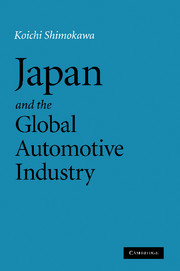Book contents
- Frontmatter
- Contents
- List of figures
- List of tables
- Preface
- Introduction
- 1 Comparing productivity of the Japanese and US automobile industries
- 2 The internationalization of the Japanese automotive industry and local production overseas
- 3 The recovery of European and US auto makers, and relocating and changing lean production
- 4 Early 1990s – the Japanese automotive industry loses international competitiveness, and the development of restructuring strategies
- 5 The restructuring of the global automotive and auto-parts industries
- 6 The restructuring of the world's auto-parts industry and the transfiguration of the keiretsu parts transaction
- 7 Global M&A and the future of the global auto industry – the light and dark sides of merger and re-alignment
- 8 The Asian and ASEAN automotive industries in the global era
- 9 China's automotive industry in the global era, Japanese auto makers, and their China strategies
- 10 Conclusion – the global automotive industry's perspective on the twenty-first century and tasks for the Japanese automotive industry
- Epilogue
- Index
- References
9 - China's automotive industry in the global era, Japanese auto makers, and their China strategies
Published online by Cambridge University Press: 06 July 2010
- Frontmatter
- Contents
- List of figures
- List of tables
- Preface
- Introduction
- 1 Comparing productivity of the Japanese and US automobile industries
- 2 The internationalization of the Japanese automotive industry and local production overseas
- 3 The recovery of European and US auto makers, and relocating and changing lean production
- 4 Early 1990s – the Japanese automotive industry loses international competitiveness, and the development of restructuring strategies
- 5 The restructuring of the global automotive and auto-parts industries
- 6 The restructuring of the world's auto-parts industry and the transfiguration of the keiretsu parts transaction
- 7 Global M&A and the future of the global auto industry – the light and dark sides of merger and re-alignment
- 8 The Asian and ASEAN automotive industries in the global era
- 9 China's automotive industry in the global era, Japanese auto makers, and their China strategies
- 10 Conclusion – the global automotive industry's perspective on the twenty-first century and tasks for the Japanese automotive industry
- Epilogue
- Index
- References
Summary
Introduction
China, which joined the WTO around the millennium, has rapidly modernized and industrialized in recent years. In fact, China's development has been so great that it has been called “the factory of the world,” and its automotive industry is about to undergo change, too. The Chinese automobile market is expanding quickly and total production has reached 5 million. Sooner or later, domestic demand will increase beyond 10 million. Therefore, China will become the main field of global competition.
One of the key factors for the global restructuring of the world's automotive industry at the end of the twentieth century was the business strategies in Asia, especially in China, which has the potential to be the world's biggest market. However, there are still many obstacles and problems to be overcome before China becomes the world's biggest automotive market and automobile-producing country. These are macro and micro problems, including problems of how to tolerate the social allocation of resources and personal mobility, including traffic, environmental and energy issues, as a social system.
China has become one of the leading producer nations for appliances, electronic devices, personal computers, and two-wheelers surprisingly quickly, and, depending on the product, has even become the world number one. However, in order to succeed in the automotive industry, you need the ability to construct complicated parts, advanced technologies for electronic devices, and information and communications, and also extremely advanced technologies for design, development, and production.
- Type
- Chapter
- Information
- Japan and the Global Automotive Industry , pp. 260 - 293Publisher: Cambridge University PressPrint publication year: 2010



